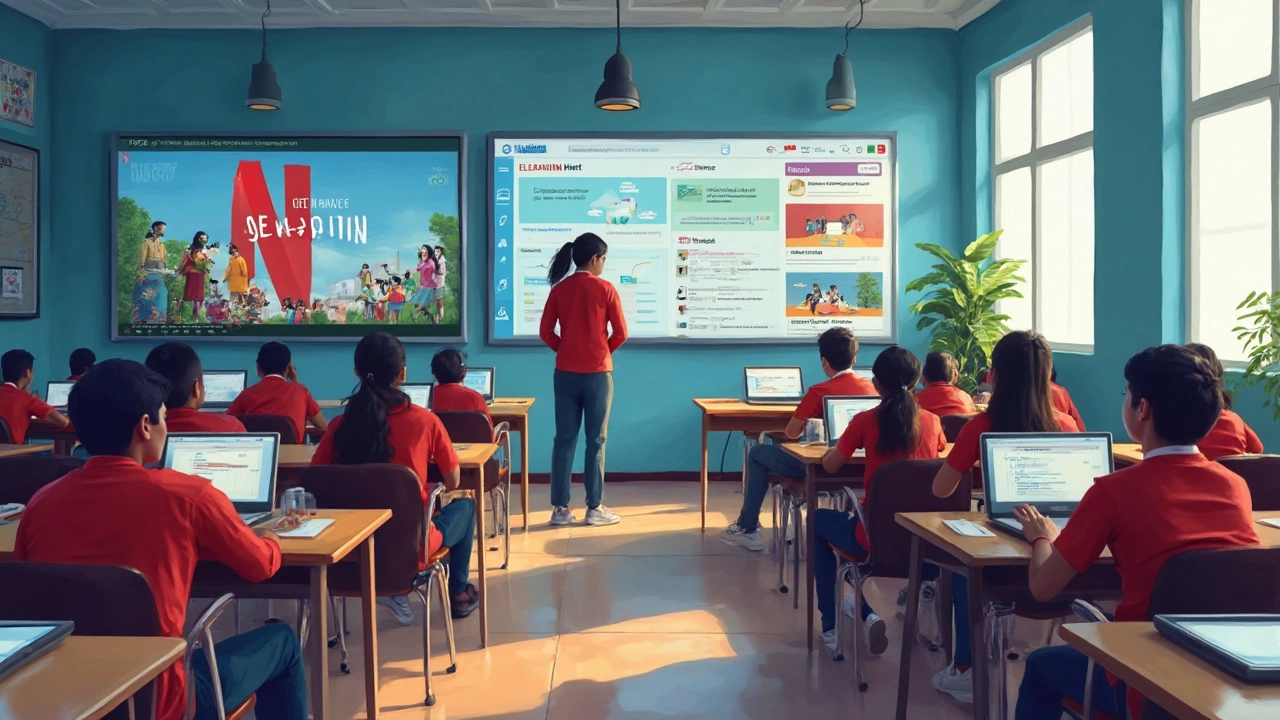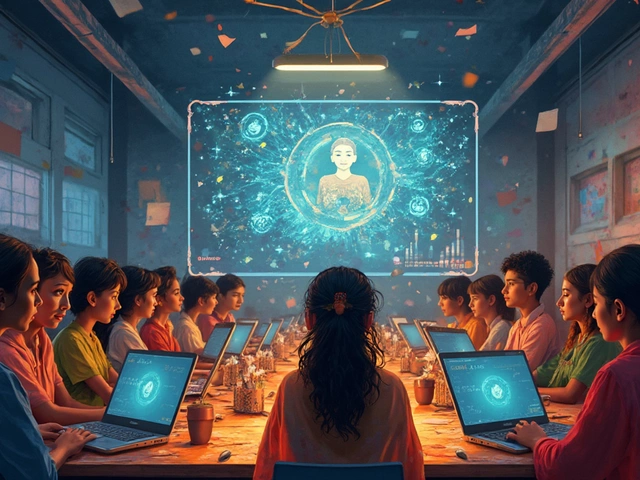You’ve probably wondered if Netflix counts as a digital platform—especially now that so many services overlap or borrow features. The term 'digital platform' gets thrown around for anything online, from streaming video to taking online classes. But there’s more to it than just being on the internet.
Netflix is famous for letting you binge your favorite shows or find new documentaries at 2 a.m., but that’s entertainment, not education. Sure, you might learn a thing or two from a documentary on Netflix, but does that make it a real e-learning tool? The answer isn’t as simple as you might think.
If you care about learning new skills, picking the right digital tool matters more than ever. There’s a huge difference between a streaming app designed for entertainment and specialized e-learning platforms that help you actually retain knowledge and track your progress. Understanding these differences will save you time and help you hit your learning goals faster.
- What Exactly Is a Digital Platform?
- How Netflix Works—And What Sets It Apart
- E-Learning Platforms: Purpose, Features, and Examples
- Choosing What Really Works for Learning
What Exactly Is a Digital Platform?
Most people throw around the term "digital platform" without thinking twice, but the meaning matters—especially if you’re picking tools for real learning. At its core, a digital platform is an online space or software where different users interact, share, and access different types of content or services. The big deal? It’s usually all about connecting people or letting them create, collaborate, or get something done.
According to experts at MIT’s Initiative on the Digital Economy:
"A digital platform enables interactions between different groups, typically consumers and producers—think of Amazon, YouTube, or Coursera."That means a real platform isn’t just a one-way street. Instead of you only receiving content, real platforms let users upload materials, join discussions, and even sell or swap ideas.
Here are a few must-have features that digital platforms usually share:
- Multiple user roles—like creators, learners, and admins
- Customizable profiles and tracking (think progress reports or recommendations)
- Tools for chatting, asking questions, or working together in groups
- On-demand access, so you can use it whenever, wherever
Check out how popular platforms compare:
| Platform | Main Purpose | User Interaction | Custom Profiles |
|---|---|---|---|
| Coursera | Online Education | Yes (forums, peer reviews) | Yes |
| YouTube | Video Sharing | Yes (comments, uploads) | Yes |
| Netflix | Entertainment Streaming | No (viewing only) | Yes |
So, just slapping your brand online doesn’t make it a platform. What matters is whether users can interact beyond just watching or reading. That’s the key to standing out in the crowded world of online tools.
How Netflix Works—And What Sets It Apart
Netflix is built around one thing: streaming video content to pretty much any device you own. When you log in, you get a menu loaded with movies, shows, and documentaries. The tech running Netflix makes it possible to watch anywhere, whether you’re on your phone at lunch or curled up in bed with a laptop. It’s quick, smooth, and rarely crashes, even if millions of people are watching the same hit series.
Every month, Netflix updates its library, buying rights to thousands of titles and creating tons of originals. To keep people hooked, Netflix spends billions—over $17 billion in 2024 alone—on new content. Their smart recommendations aren’t magic, though; they’re based on what you’ve watched, what you click, and even what you fast-forward through. This keeps your options fresh but also means you can end up in a content bubble.
Here’s where Netflix stands out, according to recent user stats:
| Fact | Netflix Data (2024) |
|---|---|
| Number of Subscribers | ~270 million |
| Hours Watched Daily | ~500 million |
| Original Shows/Movies Released in 2024 | Over 1300 |
But what makes Netflix Netflix isn’t just its size or smooth streaming. It’s the focus on entertainment, not direct skill-building or progress tracking. You can’t join a virtual class, ask questions, or earn certificates. There’s no interactive content—just video on demand. If you pause a documentary, that’s it; you don’t get review questions or quizzes like you would with an e-learning platform.
- No built-in assessments or progress tracking for learning.
- No live interaction with instructors or peers.
- Content is picked for general interest, not based on curriculum or skill gaps.
In short: Netflix is awesome for entertainment but wasn’t built as a tool to help you systematically learn new things or measure improvement. That’s where real e-learning platforms show their strength.

E-Learning Platforms: Purpose, Features, and Examples
When people talk about e-learning platforms, they mean websites or apps that focus on teaching users real skills. These platforms don’t just show videos—they track progress, test your knowledge, and help you interact with teachers or classmates. The big difference? E-learning platforms are built for learning, not just for streaming entertainment.
Take a look at what makes e-learning platforms stand out:
- Interactive content: Quizzes, assignments, and hands-on projects let you practice what you’re learning, not just watch or read about it.
- Progress tracking: You can see how far you’ve come in a course, pick up where you left off, and track your grades or results.
- Structured learning paths: Courses are organized to take you step-by-step, so you don’t get lost or overwhelmed.
- Collaboration: Many platforms have discussion boards or group projects so you can connect with other learners or ask instructors for help.
- Certificates: Complete a course and you’ll often get a certificate you can put on your resume or LinkedIn profile.
Some well-known e-learning platforms include:
- Udemy: Offers over 200,000 courses, with everything from photography to Python.
- Coursera: Partners with top universities and companies to offer professional certificates and degrees.
- Khan Academy: Totally free, great for students and teachers, with a focus on K-12 education.
- Duolingo: Fun, game-like lessons for picking up a new language.
- LinkedIn Learning: Courses tailored to workplace skills and professional growth.
Here’s a quick comparison showing how e-learning platforms stack up on key features:
| Platform | Certificates | Interactive Tools | Number of Courses |
|---|---|---|---|
| Udemy | Yes | Quizzes/Projects | 200,000+ |
| Coursera | Yes | Quizzes/Forums | 7,000+ |
| Khan Academy | No | Practice Exercises | Extensive (Mostly K-12) |
| Duolingo | No | Gamified Lessons | 30+ Languages |
| LinkedIn Learning | Yes | Video + Projects | 20,000+ |
The numbers speak for themselves. People are using these tools in huge numbers. For example, Coursera reported over 118 million registered learners worldwide in 2024, while Duolingo had over 74 million monthly active users. These platforms focus on building skills you can use, whether it’s for a job, a hobby, or school.
Choosing What Really Works for Learning
Not every digital tool built for video is actually meant for learning. When folks want to develop new skills or dive into career-changing material, it’s smart to grab something designed for education, not just entertainment. The right pick depends on what you need: live help, feedback, progress tracking, or maybe even a certificate to show off on LinkedIn.
Netflix, even though it’s top of the game for streaming, simply doesn’t offer core learning features. There’s no way to test your knowledge, chat with teachers, or see your learning streak. E-learning platforms like Coursera, Udemy, and Duolingo were built for this stuff. For example, Coursera has quizzes, due dates, and official certificates signed by top universities. Duolingo nails daily reminders, bite-sized lessons, and a points system to keep you hooked. These extras are proven to boost motivation and help you stick to a learning routine.
Let’s break down the basic facts about some popular platforms to see how they stack up for real learning:
| Platform | Features Made For Learning | Entertainment Content? | Certificates/Badges? |
|---|---|---|---|
| Netflix | Documentaries only, no quizzes, no progress tracking | Yes (main focus) | No |
| Coursera | Quizzes, assignments, instructor feedback, forums | Rarely | Yes (accredited) |
| Udemy | Video lessons, quizzes, downloadable resources | No | Yes |
| Duolingo | Interactive lessons, gamified points, daily streaks | No | Badges |
Learners also want stats before spending money. In 2024, Statista showed that over 70% of people using e-learning platforms finished at least one course, while fewer than 10% of Netflix users watched a documentary all the way through. That says a lot about how design influences commitment.
Here’s what to look for when picking a platform for serious learning:
- Is there a way to interact with teachers or other learners?
- Are there practice tests or quizzes?
- Will you get any certificate or proof of finishing?
- Is there progress tracking so you know where you stand?
- Can you fit courses into your schedule?
Stick to platforms built for learning if you want results. If you just want to chill and maybe pick up a random fact, Netflix is perfect. But when skill-building and actual progress matter, go with a real e-learning platform and use their features to keep you on track.






Write a comment: